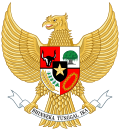First Working Cabinet Kabinet Kerja I | |
|---|---|
| 19th Cabinet of Indonesia | |
| 1959–1960 | |
 | |
| Date formed | 10 July 1959 |
| Date dissolved | 18 February 1960 |
| People and organisations | |
| Head of state | Sukarno |
| Head of government | Sukarno |
| No. of ministers | 32 ministers |
| History | |
| Predecessor | Djuanda Cabinet |
| Successor | Working II Cabinet |
| ||
|---|---|---|
Pre-independence Domestic policy Foreign policy Family | ||
| Gallery: Picture, Sound, Video | ||
The First Working Cabinet (Indonesian : Kabinet Kerja I) was an Indonesian cabinet that served from 10 July 1959 until 18 February 1960, when President Sukarno reshuffled it.

